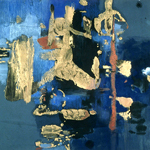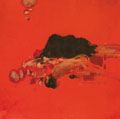An Exhibition Featuring Works by Cha Guojun and Xu Bing
August 28 to October 16, 2003
Harmony vs. Confrontation
New Calligraphy
Works by Cha Guojun and Xu Bing
August 28 - October 16, 2003
Art Beatus Gallery is pleased to present, Harmony vs. Confrontation, beginning Thursday, August 28 to October 16, 2003. New works by well-known international artists Cha Guojun and Xu Bing will be featured. The pairing of the artists' works is both engaging and thought-provoking, exploring intriguing contrasts and similarities. Mixed media paintings by Cha Guojun introduce ancient Chinese oracle bone characters into vibrant, modernized abstraction, while Xu Bing's New English Calligraphy presents an amalgamation of East-meets-Western fonts in the guise of nursery rhymes, quotations from Mao Zedong, and poetry from Western and Chinese culture. The public is invited to attend the exhibition which will open with an evening reception hosted by Art Beatus Gallery on Thursday, August 28 from 6pm to 8pm.
Cha Guojun is considered one of the most influential artists of China's Post-Cultural Revolution. Born in Kunshan City, Suzhou in 1943 and having graduated from the Shanghai Drama Institute in 1967, he worked as the head of the design department for the Children's Art Theatre in China and later as an instructor at Shanghai University. Under the constraint of China's Cultural Revolution, Cha's early works followed traditional Chinese landscape principles until moving to the West in 1985 when he was invited to the University of Minnesota as a visiting scholar in the Department of Studio Arts. Discovering the freedom to express himself in Western culture, the artist began to develop his now abstract painting style. Combining traditional Chinese media - ink and rice paper - and traditional Chinese subject matter with watercolour, oil, and acrylic, Cha creates paintings that are bold and energized, ingeniously meshing Chinese and Western aesthetics resulting in art that is emotive and alive. His work reflects his experiences with the openness of Western culture and his traditional Chinese background. Recognition from Cha's homeland came in 1995 when he was one of two artists invited to participate in a large exhibition of contemporary Chinese art at the Shanghai Art Museum. Subsequent exhibitions in both the United States and China have established him as one of the leading artists of his time to have overcome the issues of combining two variant cultures.
New
York-based artist Xu Bing first made international headlines
with the elaborate installation, Book From The Sky (1987). The
artist constructed 4000 complex and imaginary characters out of
wood blocks and hand printed them onto over 200 elegantly-bound books
and giant scrolls which were then draped across walls and ceilings. The
work was perplexing to both Chinese and international audiences alike.
Chinese viewers were surprised when they thought they would be able to
read the text, only to discover that it was unintelligible, while
international audiences interpreted it as a statement on the artist's
ruptured culture. Xu's intent was to convey the futility of
expressionism and communication in modern times, as well as the
cultural and political discord experienced in contemporary
China. Born in 1955 in Chongqing, Sichuan, Xu Bing left China in
1989 shortly after the Tiananmen Square massacre, and is one in a
generation of Chinese expatriate artists who chose to base themselves
in
the New York and Paris area. Primarily working in the art of written
language, the artist continues to delight and amuse audiences with his
series of New English Calligraphy, a writing system he created fusing
English words into square shapes resembling Chinese characters. He
presents his calligraphic script to viewers using popular children's
nursery rhymes, quotations from Chairman Mao, and adored poetry
from Eastern and Western culture. Xu Bing received recognition
for his work when he was presented with the MacArthur Award for
Genius by the John D. and Catherine T. MacArthur Foundation in
1999.

"Composition of
Characters No.1"

"Bones and Tortoise
Shells Combination - Earth"